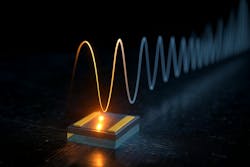Optoelectronics experts create guidelines to characterize, report, benchmark next-gen photodetectors
Vincenzo Pecunia, an associate professor who leads the Sustainable Optoelectronics Group at Simon Fraser University, answers Laser Focus World’s questions about the effort.
Advances in next-gen photodetectors are outpacing the optoelectronics research community’s ability to consistently measure and compare performance—and it makes it extremely challenging for the industry to determine which emerging photodetector technologies are truly breakthroughs and ready for real-world applications.
A team of academia and photonics industry experts from 43 universities and research institutes, and 11 companies including Panasonic, Vishay, OmniVision, Exosens, and Thorlabs, collaborated and published “Consensus Statement” guidelines to characterize, report, and benchmark these light-sensing technologies—including ones based on organic semiconductors, perovskites, quantum dots, or two-dimensional (2D) materials.
Laser Focus World: What inspired you to put together guidelines to characterize, report, and benchmark next-gen photodetectors?
Vincenzo Pecunia: The inspiration came from observing the rapid growth and diversity of emerging photodetector technologies and noticing inconsistent performance characterization and reporting across the field. The literature has often evaluated and interpreted the performance metrics of these devices inconsistently, which makes it difficult to compare them and identify genuine advances. This is a particularly important challenge because these technologies are highly promising, with some already approaching or entering industrial deployment. Therefore, we saw an urgent need for clear, community-driven guidelines to help researchers and industry benchmark devices accurately, identify the most promising solutions, and accelerate both development and commercialization.
LFW: What do you classify as next-gen photodetectors?
Pecunia: In our Consensus Statement, we define next-generation photodetectors as devices based on emerging semiconductors, including organics, perovskites, low-dimensional materials—like carbon nanotubes, 2D semiconductors, and quantum dots—and metal oxides. Unlike traditional crystalline semiconductors (Group IV or III–V), these materials aren’t constrained by lattice matching. This allows advantages such as mechanical flexibility, customizable form factors, substrate versatility, and lightweight designs. They can also be processed over large areas using scalable methods like printing, coating, or vapor deposition, which lowers costs and environmental impact. Moreover, their straightforward compositional tunability allows spectral responses to be tailored in ways not possible with conventional semiconductors. Because of such features, these technologies are prime candidates for next-generation photodetectors, with potential for widespread deployment in applications previously unattainable.
LFW: What are the key performance metrics?
Pecunia: In our Consensus Statement, we highlight key performance metrics such as dark current, responsivity, external quantum efficiency, photoconductive gain, noise, noise-equivalent power, detectivity and specific detectivity, linearity and linear dynamic range, speed of response, and stability. While these metrics are widely adopted in the broader photodetector literature, our work goes further by clarifying common misunderstandings, resolving ambiguities, and establishing standardized experimental protocols, models, and reporting requirements specifically for emerging photodetector technologies. We do so while accounting for the unique effects that arise in these emerging technologies. This approach ensures that performance can be reliably compared across devices and helps the community identify truly cutting-edge solutions as the field evolves.
LFW: Any surprises emerge while putting this together?
Pecunia: We were surprised by the amount of analysis and deliberation required to disentangle aspects often taken for granted in the emerging photodetector literature. This is because many assumptions valid for conventional photodetectors—for instance, concerning the scaling of dark current and noise, the time dependence of dark current, responsivity under underfilling beams, speed-of-response metrics, and stability characterization—do not necessarily hold for emerging technologies. Yet, the literature has often ignored these aspects, frequently applying conventional models without careful consideration of how the properties of emerging photodetector technologies would affect these metrics. For example, noise normalization according to the specific detectivity approach may fail for emerging photodetector technologies, and stability has typically relied on ad hoc protocols rather than standardized methods. Recognizing and addressing these discrepancies highlighted the need for clear, standardized guidelines tailored specifically to emerging photodetectors to ensure meaningful reporting and reliable cross-device comparisons.
LFW: Any technical challenges for next-gen photodetectors to overcome?
Pecunia: One key point we highlight in the Consensus Statement is that technical challenges depend heavily on the intended application. Next-generation photodetectors span many different materials and device configurations, each with strengths that make them well suited for certain scenarios and less ideal for others. This is one of the major challenges we identified in the emerging photodetector literature: Performance is often evaluated narrowly and in absolute terms, rather than in relation to the diverse requirements of specific applications. Therefore, our Consensus Statement emphasizes that, instead of defining a single list of performance requirements that these technologies must meet to be ‘ready,’ it is more meaningful to consider challenges in the context of where and how the devices will be used. Otherwise, there is a risk of oversimplifying both the capabilities and the potential of these technologies.
More broadly, the main challenges are essentially underexplored research opportunities. Upscaling is one: Much research has focused on standalone-device demonstrations, which are entirely appropriate for proving concepts. But real-world deployment requires moving toward scalable prototypes, large-area uniformity, integration with electronics, and holistic system-level design.
Another area that would benefit from more systematic study is stability characterization—particularly under standardized conditions and accelerated testing protocols. This isn’t to suggest these devices are inherently unstable—similar materials in photovoltaics have already demonstrated excellent long-term performance—but rigorous, comparable data in photodetector studies remain sparse. Systematic stability studies would help identify best-in-class devices and accelerate their translation to real-world applications.
LFW: What do you hope your guidelines offer/provide the optics/photonics community?
Pecunia: We hope the guidelines will serve both researchers and industry by providing a clear, shared framework for evaluating and reporting next-generation photodetectors. For researchers, the guidelines clarify common misunderstandings, standardize key measurements, and promote reproducibility, which makes it easier to compare results and identify genuine advances and new directions. For industry, they provide a foundation to help assess which technologies are truly ready—or nearly ready—for real-world deployment, accelerating translation into practical applications. By connecting rigorous performance assessment with real-world relevance, the guidelines aim to support meaningful progress across the entire photodetector community.
LFW: Interesting trends emerging within the next-gen photodetector space?
Pecunia: There is so much to discuss in terms of interesting trends emerging within the next-gen photodetector space, so I’ll focus on a few key examples. One exciting trend is the development of filter-free spectrometers at sub-millimeter scales, enabled by the unique optoelectronic properties of emerging materials. Another is ultra-narrowband detection (spectral width ≤ 10 nm) without optical filters. We’re also seeing devices that can access spectral ranges far beyond silicon or conventional III-V semiconductors, extending well into the infrared. Coupled with scalable, low-cost fabrication techniques like printing and coating, these advances create unprecedented opportunities to embed photodetectors into everyday objects and environments, with applications ranging from precision agriculture and intelligent packaging to environmental monitoring, materials characterization, medical diagnostics, and Industry 4.0.
CONSENSUS STATEMENT
V. Pecunia et al., Nat. Photon., 19, 1178–1188 (2025); https://doi.org/10.1038/s41566-025-01759-1.

